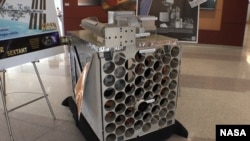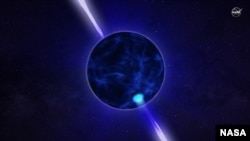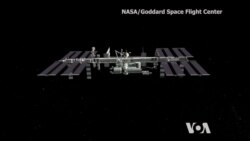It will be a few more days before Space X’s Dragon cargo capsule reaches the International Space Station (ISS). Bad weather postponed the launch scheduled for Thursday until Saturday. Among other supplies for the ISS crew, it carries an unusual telescope designed to look at not-well-known objects called neutron stars. These relatively small celestial bodies have some mind-boggling features, for example, a teaspoon of their matter weighs about 10 million tons.
Looking at a life-size model of the Neutron Star Composition Explorer, or NICER for short, displayed at the Goddard Space Center, one can immediately see that it is not an optical telescope.
The most visible part of Nicer is a one-meter-wide cube, made of solid aluminum with 56 holes drilled through its face. The instrument houses its own array of special lenses that deflect x-rays and focus them towards sensors fixed on the inner wall behind them.
Outside, it looks a little like the WWII Katyusha rocket launcher.
On top, it has a few appendages housing auxiliary equipment, as well as a socket for the ISS’s robotic arm that will eventually install it outside the orbital station.
Neutron stars
Standing next to the cube, deputy principal investigator for the NICER Mission, astrophysicist Zaven Arzoumanian, says that not much is known about neutron stars, the densest objects in the universe.
“They are only about 16 to 20 kilometers across but can contain the mass of up to two of our suns compressed into that tiny volume so we think they are made mostly of neutrons.”
But how is that possible when everything we know is made of atoms?
That's true, Arzoumanian explains, “but the distance between nuclei of individual atoms is very large and is occupied by electrons that have very little mass, so it’s mostly empty space. If you could imagine having a lump of gold and crushing it to the point where you bring the nuclei closer and closer together until they're touching, when there's no more empty space the electrons are absorbed by the protons, they cancel each other out, they turn into neutrons and you're left with a ball of neutrons."
The only force that is capable of crushing atoms together to that point is gravity, and for gravity to be strong enough to do that you need one or two times the mass of the Sun collapsing and compressing, crushing itself under its own weight and you're left with what we think is a neutron star,” he said.
At this point, the physics of a neutron star becomes murky. Perhaps under those conditions, neutrons and protons aren't able to maintain their identities any more, Arzoumanian suggests. They may dissolve into a soup of even smaller particles - quarks and gluons. What we know, he adds, is that neutron stars rotate at very fast and constant speed and that they are very powerful sources of x-rays.
Pulsating beacons
If the Earth is in the path of the rotating beams, we see them as pulsating sources of light, as well as x-rays, which is why such neutron stars are also called pulsars.
“Imagine that you have a beach ball with a hot spot in the front and a hot spot in the back and the beach ball is spinning,” says Arzoumanian. “You see the hotspot come around towards you, you see the brightness increase, but there's a hot spot in the back as well and eventually that swings around. So imagine the brightness as a function of time, it goes up and down deeply as the spots swing in and out of view.”
In a simplified way, he says, how deep that light variation is, how deeply it is modulated or how it varies, is a measure of how big the star is, how compact it is and it will tell us about its interior contents.
Spider's eye
Building the NICER’s 56 eyes, sensitive to x-rays, required some marvelous ingenuity, as those rays don't behave like visible light. Its lenses are in fact 24 concentric aluminum cylinders, coated with a thin layer of gold, and bent very slightly lengthwise.
“X-rays prefer to pass through things rather than to be focused,” explains Arzoumanian, “so there's a unique geometry to these mirrors, which is very similar to skimming a stone on a pond. If you drop a pebble into water vertically it passes through. X-rays work the same way. But if you throw the pebble onto the water at a very sharp angle, you can skim it off the surface and these mirrors work the same way, the x-rays come in at a grazing angle and are redirected very slightly to focus at some distance downstream.”
But neutron stars emit all kinds of radiation, from low frequency radio waves to extremely high frequency gamma rays. Why concentrate on x-rays?
There are two reasons, says Arzoumanian, one scientific and one technological.
“The surface of the neutron star is glowing in x-ray light and for us to understand the size of the star, which is a direct way of understanding the interior makeup of the star, we need to be looking at the surface and the surface is glowing and x-rays so we look where we have to look to understand.”
The other technological reason, he says, has to do with the SEXTANT Mission that will use the same telescope.
Celestial GPS
A sextant is the optical instrument that mariners, and later airmen, have used since the 18th century to navigate when far from dry land. It was essential on ships until the U.S. military satellite-based navigation system, now known as GPS, was made available for civilian use.
GPS, which stands for Global Positioning System, relies on a number of satellites in geostationary orbit. When a GPS receiver, now embedded in most smartphones, establishes contact with at least three satellites that are over the horizon, the computer in it automatically calculates its exact position.
SEXTANT stands for Station Explorer for X-ray Timing and Navigation Technology. Jason Mitchell, the mission's project manager, says pulsars are so stable in the rotation that often you'll hear the analogy of a celestial lighthouse or a celestial clock.
“Their spins are so accurate,” says Mitchell, “they rival atomic clocks here on Earth. So in analogy to GPS global positioning system, you can think about pulsars as objects in very precise orbits that transmit very precise timing signals.”
Mitchell says the worst possible scenario we can think of happening to future manned space explorations would be the inability to communicate with Earth. So we want to make sure that in such an event, the astronauts can perform their function and return home safely. An autonomous navigation system like this could certainly help, he says, as strong x-ray emissions from pulsars could serve as guiding beacons.
Mitchell adds that the SEXTANT team plans to conduct two experiments with the NICER telescope – one relatively early in the mission and another toward the end of its use by NASA researchers, about 18 months after its launch.
After that time, the telescope will become available to scientists and researchers worldwide.














